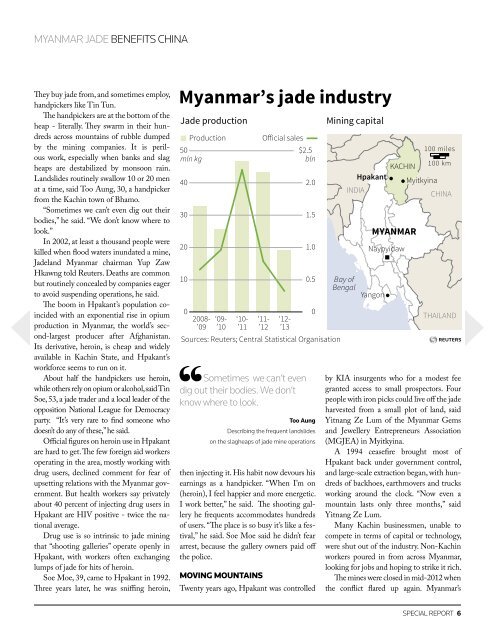You also want an ePaper? Increase the reach of your titles
YUMPU automatically turns print PDFs into web optimized ePapers that Google loves.
<strong>MYANMAR</strong> <strong>JADE</strong> BENEFITS CHINA<br />
They buy jade from, and sometimes employ,<br />
handpickers like Tin Tun.<br />
The handpickers are at the bottom of the<br />
heap - literally. They swarm in their hundreds<br />
across mountains of rubble dumped<br />
by the mining companies. It is perilous<br />
work, especially when banks and slag<br />
heaps are destabilized by monsoon rain.<br />
Landslides routinely swallow 10 or 20 men<br />
at a time, said Too Aung, 30, a handpicker<br />
from the Kachin town of Bhamo.<br />
“Sometimes we can’t even dig out their<br />
bodies,” he said. “We don’t know where to<br />
look.”<br />
In 2002, at least a thousand people were<br />
killed when flood waters inundated a mine,<br />
Jadeland Myanmar chairman Yup Zaw<br />
Hkawng told Reuters. Deaths are common<br />
but routinely concealed by companies eager<br />
to avoid suspending operations, he said.<br />
The boom in Hpakant’s population coincided<br />
with an exponential rise in opium<br />
production in Myanmar, the world’s second-largest<br />
producer after Afghanistan.<br />
Its derivative, heroin, is cheap and widely<br />
available in Kachin State, and Hpakant’s<br />
workforce seems to run on it.<br />
About half the handpickers use heroin,<br />
while others rely on opium or alcohol, said Tin<br />
Soe, 53, a jade trader and a local leader of the<br />
opposition National League for Democracy<br />
party. “It’s very rare to find someone who<br />
doesn’t do any of these,” he said.<br />
Official figures on heroin use in Hpakant<br />
are hard to get. The few foreign aid workers<br />
operating in the area, mostly working with<br />
drug users, declined comment for fear of<br />
upsetting relations with the Myanmar government.<br />
But health workers say privately<br />
about 40 percent of injecting drug users in<br />
Hpakant are HIV positive - twice the national<br />
average.<br />
Drug use is so intrinsic to jade mining<br />
that “shooting galleries” operate openly in<br />
Hpakant, with workers often exchanging<br />
lumps of jade for hits of heroin.<br />
Soe Moe, 39, came to Hpakant in 1992.<br />
Three years later, he was sniffing heroin,<br />
Myanmar’s jade industry<br />
Jade production<br />
40<br />
30<br />
20<br />
10<br />
0<br />
Production<br />
50<br />
mln kg<br />
2008-<br />
’09<br />
‘09-<br />
’10<br />
‘10-<br />
’11<br />
Official sales<br />
‘11-<br />
’12<br />
‘12-<br />
’13<br />
$2.5<br />
bln<br />
2.0<br />
1.5<br />
1.0<br />
0.5<br />
Sources: Reuters; Central Statistical Organisation<br />
Sometimes we can’t even<br />
dig out their bodies. We don’t<br />
know where to look.<br />
Too Aung<br />
Describing the frequent landslides<br />
on the slagheaps of jade mine operations<br />
then injecting it. His habit now devours his<br />
earnings as a handpicker. “When I’m on<br />
(heroin), I feel happier and more energetic.<br />
I work better,” he said. The shooting gallery<br />
he frequents accommodates hundreds<br />
of users. “The place is so busy it’s like a festival,”<br />
he said. Soe Moe said he didn’t fear<br />
arrest, because the gallery owners paid off<br />
the police.<br />
MOVING MOUNTAINS<br />
Twenty years ago, Hpakant was controlled<br />
0<br />
Mining capital<br />
Bay of<br />
Bengal<br />
100 miles<br />
KACHIN<br />
100 km<br />
Hpakant<br />
Myitkyina<br />
INDIA<br />
CHINA<br />
<strong>MYANMAR</strong><br />
Naypyidaw<br />
Yangon<br />
THAILAND<br />
by KIA insurgents who for a modest fee<br />
granted access to small prospectors. Four<br />
people with iron picks could live off the jade<br />
harvested from a small plot of land, said<br />
Yitnang Ze Lum of the Myanmar Gems<br />
and Jewellery Entrepreneurs Association<br />
(MGJEA) in Myitkyina.<br />
A 1994 ceasefire brought most of<br />
Hpakant back under government control,<br />
and large-scale extraction began, with hundreds<br />
of backhoes, earthmovers and trucks<br />
working around the clock. “Now even a<br />
mountain lasts only three months,” said<br />
Yitnang Ze Lum.<br />
Many Kachin businessmen, unable to<br />
compete in terms of capital or technology,<br />
were shut out of the industry. Non-Kachin<br />
workers poured in from across Myanmar,<br />
looking for jobs and hoping to strike it rich.<br />
The mines were closed in mid-2012 when<br />
the conflict flared up again. Myanmar’s<br />
SPECIAL REPORT 6


